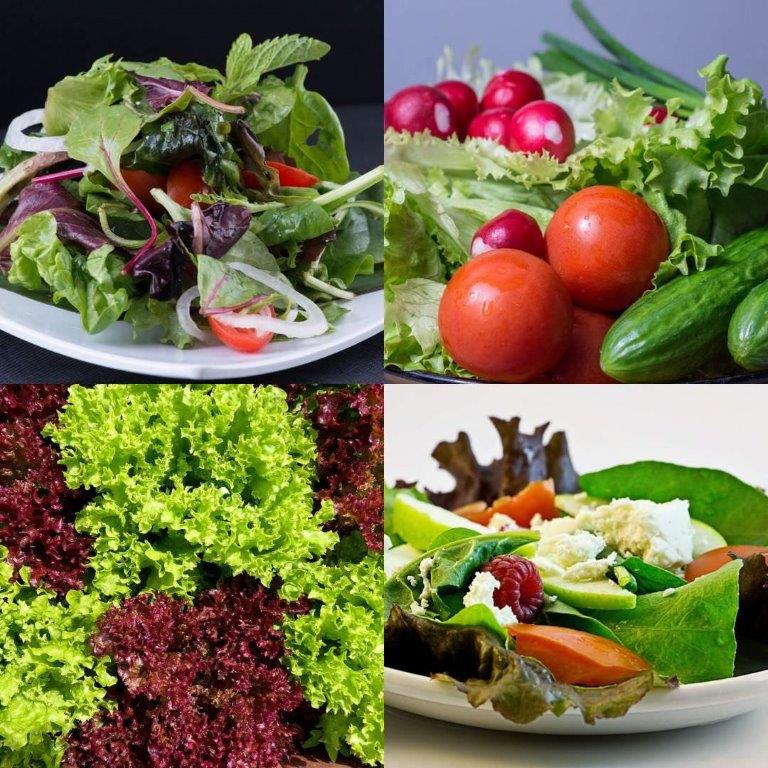
12 Tips to Make Incredible Green Salads
Green Salads are much more than boring iceberg lettuce with carrot shavings and bottled dressing. There are so many wonderful possibilities for salads, sometimes we just need a little inspiration. Listed below are some tips and suggestions turning that ho-hum pile of greens shoved to the side of the plate into the main attraction.
Green Salads Inspiration: The Base
1. Consider a Salad Spinner
It’s essential to wash lettuce before eating it thoroughly, but it can be challenging to get it dry enough to hold your dressing. If you eat a lot of salad, a salad spinner is definitely worth the investment.
2. Mix the Greens
Some salads, like a classic Caesar Salad or Spinach Salad, are meant to have a single type of green. But mixing several kinds of lettuce will add more texture and flavor. Make your own salad mix at home with a head of your favorite lettuce, some arugula or watercress, or spinach. Wash and tear into bite-sized pieces then store in a zip lock bag with all of the air pressed out. Grab what you need for your salad then press the air out of the bag again to save for the next day.
3. Adding Raw Kale to a Salad
Raw kale and other tough greens like mustard greens can be a delicious addition to your greens mix if you know the trick. Wash and dry the kale, cut out the center stem and cut into bite-sized pieces. Finally, rub with a little olive oil and salt to soften them up before adding to the salad.
4. Add Fresh Herbs
Fresh leafy herbs such as cilantro, parsley, basil, and oregano can add wonderful flavor to any salad. Just wash and remove the tender leaves from the stems and add to your green mix.
5. Skip the Greens Altogether
Yes, you can make a salad without any leafy greens at all. Tabbouleh is made with bulgur wheat. Panzanella uses bread as a base. Caprese Salad uses tomatoes. Uborkasalata and Jajuk use cucumbers. You might also enjoy this Broccoli Salad, or Carrot Salad or this Roasted Beet Salad.
Green Salads Inspiration: The Extras
What else should you add to your salad? This is where your salad creativity can really shine. Vegetables, nuts, seeds, fruit, meats, cheeses, sprouts, croutons, etc. Try adding different textures and flavor combinations to keep your salad interesting.
6. Grate, Cube, and Slice for Variety
Beets, carrots, and even cheese can be grated or cubed before being added to a salad. If you really want to get creative, you can slice cheese and cut with small cookie cutters.
7. Toast Nuts for Added Flavor
Take a few extra minutes and toss some nuts or seeds into a small skillet on medium. The roasting brings out the oils and makes them taste nuttier, for lack of a better description.
8. Make Your Own Sprouts
Sprouts and microgreens (seedlings picked when they are only an inch or two high) are a delicious addition to add to salads but are expensive to buy. Luckily, they are easy to make at home. And as a bonus, the process of sprouting uses up much of the carbohydrates in the seed making it an excellent low carb addition.
Green Salads Inspiration: The Dressing
The dressing is the final touch that brings the other ingredients together. I have not purchased store-bought salad dressing in decades. Homemade is BETTER. Easy to make and customize too.
9. Make the Dressing in the Bowl
Save time cleaning up by making your salad dressing in the same bowl you plan to serve your salad in. Mix up your dressing ingredients and let them sit for a while to give the flavors a chance to meld. Then add the rest of your salad ingredients to the bowl and toss to coat right before serving. If you make more dressing than you need for one salad, simply pour off the excess into another storage container before adding your salad ingredients.
10. Add an Emulsifier to Vinaigrettes
When making homemade vinaigrettes, add a little Dijon mustard or mayonnaise to emulsify the mixture. This will help hold together the oil and vinegar (or other acidic components) longer.
11. Add the Dressing Just Before Serving
No one likes a soggy salad. Don’t add the dressing until right before you serve it to keep your lettuce crisp.
12. Take it on the Go
If you need to take your salad on the go, but dread soggy, wilted lettuce – try layering your ingredients. A good rule of thumb is to always put the dressing on the bottom (or in another container), followed by “tougher” ingredients like carrots and celery. Next up, add proteins like chicken breast or sliced eggs and then top with delicate lettuce or spinach leaves.
Homemade Salad Dressing Recipes to Get You Started
- Blue Cheese Dressing
- Classic Caesar Dressing
- Creamy Ginger Dressing
- Creamy Lemon-Herb Dressing
- Honey Lime Pesto Dressing
- Honey Mustard Dressing
- Lemongrass Dressing
- Lighter Thousand Island Dressing
- Poppyseed Dressing
- Tea Infused Dressing
The final tip is to use fresh, organic, in-season produce, preferably locally grown. Strawberries in December are flavorless, but in late Spring and Summer, they are bursting with sweetness and are fabulous in a salad. Winter salads sometimes take a little more creativity with the extra ingredients, while lettuce can be scarce in the summer and you need to get creative with the base. With a bit of creativity and experimentation, you can enjoy fabulous green salads year-round.
- Garlic Kale Soup – Use All That Wonderful Spring Produce
- Catalogna Chicory Salad with Grapefruit and Pumpkin Seeds
- Organic Lemons Are Great For Your Health
- Cheddar Beet Risotto – Sweet and Creamy
- Sweet Potato Stuffed with Avocado
- Microgreens and Tuna Salad – Nutrient Rich
- Swiss Chard with Onions and Vinegar
- Benefits of Beets – Elevated to Superfood Status
- Get the Most Out of Your Harvest Delivery – Ten Tips
- Storing Greens – 5 Rules for Lettuce, Cabbage, Other Greens
- Stuffed Squash with Quinoa and Sausage – Nutritionally Packed
- Zutano Avocado – A Rare Tasty Delight
- Arugula Strawberry Salad – With Salmon
